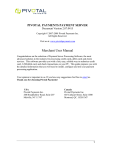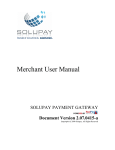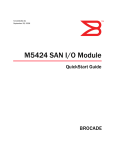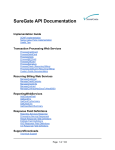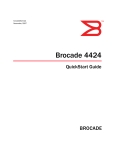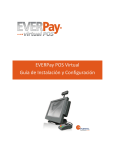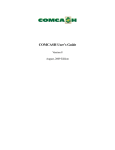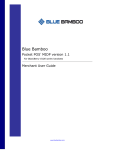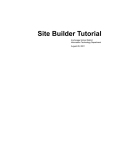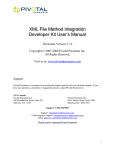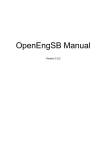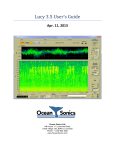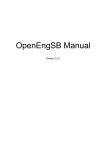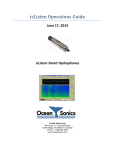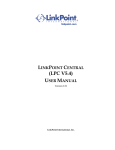Download Virtual Terminal User Manual
Transcript
Virtual Terminal User Manual LUCYTM Gateway User Guide for Merchants LUCYTM Gateway • 45 West 36th Street • 6th Floor • New York City, NY 10018 Phone: 866.222.7527 • E-mail: [email protected] ii TABLE OF CONTENTS End of Day 36 3 Find Transactions 37 Manage Users 5 Transaction Summary 37 Adding a New User 5 Find Card Transactions 39 Finding and Editing Users 6 Find Check Transactions 45 Creating Transactions with Virtual Terminals 9 Void Transactions 48 Credit Card 9 Refund Transactions 49 Credit Card -Sale 9 Repeat Sale Transactions 50 Beginning to Use the Payment Server 1 Log in as a Merchant 2 Menu Bar Credit Card – Pre-Auth 12 Capture Pre-Auth Transactions 51 Credit Card – Force-Auth 13 Recurring Billing 53 Debit Card -Sale 15 Add & Edit a Customer 53 Debit Card –Return 16 Add & Edit a Payment Item 55 Check 17 Add & Edit a Contract 58 Check -Sale 18 View Customers 61 Check -Verify 19 View Contracts 63 Check -Force Sale 20 Billing Report 64 Check -Void 22 Preferences and Merchant Support 66 Check -Return 23 User Access Control 66 Gift Card 24 Allow All IPs/Countries 67 Gift Card –Redeem 24 Deny All IPs/Countries 68 Gift Card -Reload 25 Setting up Input Devices 70 Gift Card -Refund 26 Setting up Card Reader 71 Gift Card -Activate 27 Setting up PIN pad 72 Gift Card -Deactivate 28 Setting up Check Reader 73 Gift Card -Inquire 29 Changing User Password 74 Batches and Settlements 30 Setting Security 75 Current Batch 30 Sending E-mails to Merchant Support 77 Closed Batches 32 System Logout 77 Settle Totals 34 I C H A H N P T A D E R P E iii Overview Information By using the LUCYTM (let us connect you) Gateway, merchants have the ability to process and review transactions and activity 24 hours a day, seven days a week, manage their on-line experience and setup new user accounts and modify or delete existing user accounts, all right at their fingertips. Merchants can also upload Point-of-Sale (POS) transactions from their terminals and capture the images of signed sales drafts. As a result, merchants no longer have to hold copies of these transactions for retrieval requests. Instead, the images are housed on the web and available to the merchants through the Internet. In addition, merchants have access to manage accounts at the user level*. The target audience for this documentation is individuals who will be using the LUCYTM Gateway on a regular basis to fulfill their payment processing needs. Basic computer skills will facilitate the use of the LUCYTM gateway, but are not required. *Note: Managing user accounts is dependent on the merchant’s assigned security permissions. iv Beginning to Use the LUCY Gateway TM What to Expect and What to Do When Beginning to Use the LUCYTM Gateway for payment processing. In this introductory chapter, you will learn the basic steps necessary to begin to use the LUCYTM Gateway for payment processing. The topics covered include the login process, the payment server’s graphical user interface (GUI), and the user account management. To begin using the LUCYTM Gateway, you must first log in to the system. The following Step/Action table illustrates the login process. Step Action Display 1. Open your internet browser. 2. Type the Uniform Resource Locator (URL) for the payment server login page in the Address field (https://payments.cynergydata.com). Consult the system administrator for the LUCYTM Gateway if you are unsure of the correct URL. FIGURE 1.1. Displaying the login page for the LUCYTM Gateway 1 Payment Server Login (continued) Step Action 3. Input your user name in the username field. 4. Input your password in the password field. 5. Click Login (The Reset button lets you re-enter your username and password). Information Display If this is your first time logging on to the payment server, you will see an End User Licensing Agreement (EULA). To continue your login, read the agreement and click the I agree button. FIGURE 1.2. Displaying EULA (End User License Agreement). You will only see this page one time once you agree to the terms. Log in as a Merchant Information After you log in to the system as a merchant, a menu bar will appear on the left of the screen. It contains a list of options: Virtual Terminals, Recurring Billing, Current Batch, End of Day, Closed Batches, Find Transactions, Manage Users, Preferences, E-mail and Logout. The Manage Users feature is discussed in this chapter. All other features will be discussed in following chapters. 2 Log in as a Merchant (continued) FIGURE 1.3. Displaying the payment gateway in a browser window Information The Menu Bar on the left side of your browser window has up to ten folders plus a Logout icon. Each folder has a small plus sign (+) to the left, meaning those folders each have one or more sub folders or links for further selection. Click on the plus signs (+) to expand the folders and see the contents. The following table describes each folder and its contents. Notice you may not be able to see all ten folders and all the links inside the folders, depending on your merchant’s payment processor setup. FIGURE 1.4. A fully expanded Menu Bar Credit Debit Checks Gift Cards Add Customer View Customers View Contracts Billing Report VirtualTerminals Process Sale, PreAuth or ForceAuth transactions for a credit card. Process Sale or Return transactions for a debit card. Process Sale, Verify (PreAuth), Void, Return or ForceSale (PostAuth) transactions for a check. Process Redeem, Reload, Refund, Activate, Deactivate or Inquire transactions for a gift card. Recurring Billing Add a new customer for recurring billing. Display established recurring billing customers. Display established contracts for customers. Display transactions processed through recurring billing. 3 Menu Bar FIGURE 1.4. (Continued) Summary Credit/Debit/EBT Credit/Debit/EBT Summary Credit/Debit/EBT Summary Credit/Debit/EBT Add Find/Edit Access Control Device Setup Password Security Sales Support Logout Current Batch Display a summary list of transactions in the current batch Display the transaction details in the current batch. End of Day Display the current batch summary and allow you to submit the batch. Closed Batches Display a summary list of transactions in the current batch Display the transaction details in the current batch. Find Transactions Display a summary list of all transactions categorized by the payment type. Display the current batch summary and allow you to submit the batch. Manage Users Add a new user account. Find, edit or delete user accounts. Preferences Grant or deny access to log in to an account by verifying the IP address. Set up PinPad, Card Reader and Check Reader devices connected to your system. Change the user password. Set security for functions performed at the user level. Email Send email to the LUCYTM Gateway sales team. Send email to the LUCYTM Gateway support team. Logout Exit the LUCYTM Gateway. 4 Manage Users Adding a New User Information • The Manage Users section is used to add, find, edit, or delete user accounts. The examples below show two scenarios when you would want to add a new user. Your company must establish a user account for each terminal. This account is set up specifically to upload transactions and sales draft/check images to the web. Your company wants to establish a user account for an office manager. This manager needs a user name and password for access to retrieve images and view reports. • Information Step Use the following Step/Action table for assistance when creating a new user account. Action 1. Click on the Manage Users folder. 2. Click on the Add link to add a new user. Display FIGURE 1.5. Entering new user information • • Without specifying a user name in the User Name field, the payment server will generate a user name for you. The First Name and Last Name fields are where you will need to identify the terminal that will be uploading to this account or the entity that will be using this account. 5 Adding a New User • The Security Level box should be defined correctly to grant the user access to perform his/her job duties. For more information on security level settings, see Setting Security on page 75. Step Action 3. Enter the new user’s information into the User Information form. 4. Click on the Save User button (The Reset button allows you to return to the previously saved User Information settings). Display Finding and Editing Users Information Step The Find/Edit function lets you manage the user account, such as, search a user account, modify the previously entered user information, delete an existing user, activate or inactivate a user account, etc. Use the following Step/Action table for assistance. Action 1. Click on the Manage Users folder. 2. Click on the Find/Edit link. Display FIGURE 1.6. Entering target user information Step Action Display 3. Fill out the field(s) that you know for your target user in the Show Filters form. Notice, without entering any information in the filter form, all user accounts will be returned in a list. 4. Click Find (The Reset button clears the form and lets you re-enter the information). 6 Finding and Editing Users (continued) FIGURE 1.7. Displaying a list of users (Notice the and arrows under each column name are for sorting the list). Step Action 5. To send an email to the user, click on the Email link. Your default mail application will pop up for you to email the user. 6. To view, edit or delete the user, click on the User Name link. The following figure will appear. Display FIGURE 1.8. Displaying User information Step Action 7. To edit the user, click the Edit User link in the upper right corner of the User Information window. Display Figure 1.9. Displaying the detail of user information 7 Finding and Editing Users (continued) Step 8. Action Display Edit the fields as necessary, and click Save User to save the changes. Figure 1.10. The User Information box will appear after clicking Save User. Information The following table continues to describe the function of each link in the figure above. Link Email:[email protected] m Function To send the user an email with your default mail application. Reset Password To reset the password. The payment server automatically generates a new user password. Email Password To send the user his/her password, in the context of a pre-defined email template (See Figure 1.11 below). Log In as this User Delete User Make User Inactive OR Make User Active To log in as this user, primarily to test security and functionality. To delete the user. Notice, you cannot delete a primary user. A primary user is created when a merchant or reseller account is first created. To make the user active or inactive FIGURE 1.11. Emailing the user his/her initial password generated by the payment gateway. 8 Creating Transactions with Virtual Terminals How to Use Virtual Terminals. Virtual Terminals allow you to process various transactions on credit card, debit card, check, and gift card. The transaction types include Sale, PreAuth (pre-authorization), ForceAuth (postauthorization), Void, Return, etc. This chapter describes how to process each type of transaction, grouped by the payment methods: Credit Card, Debit Card, Check, and Gift Card. To process retail transactions, you will need various devices, such as card reader, PIN pad, and check reader. Refer to Setting up Input Devices on page 70 for details. Credit Card Information The virtual terminal does not facilitate Void and Return transactions on credit cards. Instead, these functions are provided through the Find Transactions function. This is to ensure a void or return transaction can only to be made on an existing transaction, and thereby reduce opportunity for fraud. Credit Card –Sale Step Action 1. Click on the Virtual Terminals folder. 2. Click on the Credit link 3. Click on the Sale tab. See FIGURE 2.1. Display 9 Credit Card – Sale (continued) FIGURE 2.1. Entering the credit card sale information Step Action 4. Enter the credit card information into the Credit Card Sale form. 5. By checking the Force Duplicate box, you can process a duplicate transaction. A duplicate transaction is an attempted transaction identical to the one already made on the same day, with the same credit card number, expiration date, and total amount. 6. The Repeat Sale function is designed for a credit card payment with installments. If this transaction is a repeat sale, check the Repeat Sale box to expand the section. Otherwise, skip this step and go to Step 8. Display FIGURE 2.2. Filling out the Repeat Sale fields 10 Credit Card – Sale (continued) Step Action 7. Fill out the two fields in the Repeat Sale section for an installment payment. 8. Press Process (The Clear button lets you clear the form). The payment gateway will generate a receipt you can print for your customer. FIGURE 2.3. Displaying a credit card sale receipt Display FIGURE 2.4. Displaying a credit card repeat sale receipt 11 Credit Card – Pre-Auth Information Step Pre-Auth is the process of authorizing and reserving the funds for the transaction. This ensures the card is valid and the cardholder has sufficient open-to-buy funds to cover the purchase amount plus any tip, shipping fees or other costs involved with the sale, and reserving the funds to complete the sale. Action 1. Click on the Virtual Terminals folder. 2. Click on the Credit link. 3. Click on the PreAuth tab. See FIGURE 2.5. Display FIGURE 2.5. Entering the credit card pre-auth information Step Action 4. Enter the credit card information into the form. 5. Press Process (The Clear button clears the transaction from the form). Display 12 Credit Card – Pre-Auth (continued) FIGURE 2.6. Displaying a credit card Pre-Auth receipt FIGURE 2.7. Displaying a credit card Pre-Auth receipt after clicking Print Receipt Credit Card – Force-Auth Information Step Force-Auth is a sale transaction for which a merchant received a voice authorization. A Force-Auth is done so that the previously authorized transaction can be settled and the merchant can receive funds. Action 1. Click on the Virtual Terminals folder 2. Click on the Credit link. 3. Click on the ForceAuth tab. See FIGURE 2.8. Display 13 Credit Card – Force-Auth (continued) FIGURE 2.8. Entering the credit card Force-Auth information Step Action 7. Enter the customer’s credit card information into the form. 8. Press Process (The Clear button lets you clear the form). Display FIGURE 2.9. Displaying a credit card Force-Auth receipt 14 Debit Card Information Virtual Terminals allow you to process Sale and Return (void) transactions on debit cards. To process debit card transactions, you need to first connect both a PIN (Personal Identification Number) pad and a card reader with your computer. Refer to Setting up Input Devices on page 70 for details. Debit Card -Sale Step Action 1. Click on the Virtual Terminals folder. 2. Click on the Debit link. 3. Click on the Sale tab. See FIGURE 2.10. Display FIGURE 2.10. Entering the debit card sale information Step Action Display 4. Swipe a debit card on a card reader. The Card Number and Expiration Date fields will be automatically populated after the swiping. 5. Enter other transaction information into the form. 6. Press Process (The Clear button lets you clear the form). 7. The PIN pad connected to your computer will prompt you to enter a PIN. Input the number and press the Enter key on your PIN pad. 15 Debit Card – Sale (continued) FIGURE 2.11 Displaying a debit card sale receipt. Debit Card – Return Step Action 1. Click on the Virtual Terminals folder. 2. Click on the Debit link. 3. Click on the Return tab. See FIGURE 2.12. Display FIGURE 2.12. Entering the debit card return information 16 Debit Card – Return (continued) Step Action Display 4. Swipe a debit card on a card reader. The Card Number and Expiration Date fields will be automatically populated after the swiping. 5. Enter the PNRef number into the PNRef field. This number you obtained from your earlier processed debit card sale transaction, on which you are performing the return transaction. 6. Enter other transaction information into the form. 7. Press Process (The Clear button lets you clear the form). 8. The PIN pad connected to your computer will prompt you to enter a PIN. Input the number and press the Enter key on your PIN pad. FIGURE 2.13. Displaying a debit card return transaction receipt Check Information Currently, the LUCYTM Gateway supports Rocky Mountain Retail System as its check processor. You will see the following user interface for your check processing: Rocky Mountain Retail System: This section describes Sale, Verify (Pre-Auth), Void, ForceSale (Post-Auth) and Return check transactions crossed on the check processor. 17 Check –Sale Step Action 1. Click on the Virtual Terminals folder. 2. Click on the Checks link. 3. Click on the Sale tab. See FIGURE 2.14. Display FIGURE 2.14. Entering the check sale information Step Action 4. Enter the check information into the form. 5. Press Process (The Clear button lets you clear the form). Display 18 Check – Sale (continued) FIGURE 2.15. Displaying a check sale receipt Check – Verify Information Step Check verification is a process that screens checks and check writers against a “negative database” of “bad check writers”. Action 1. Click on the Virtual Terminals folder. 2. Click on the Checks link. 3. Click on the Verify tab (See FIGURE 2.1.7 on the next page). 4. Enter the check information into the form. 5. Press Process (The Clear button lets you clear the form). Display FIGURE 2.16. Displaying a check verification receipt 19 Check – Verify (continued) FIGURE 2.17. Entering the check verification information Check – ForceSale Information Step Check ForceSale is a process that completes a check transaction that already went through the check verification phase and proved to be a “good check”. Therefore, to make a check force sale, you must provide the reference number obtained from the earlier check verification process. Action 1. Click on the Virtual Terminals folder. 2. Click on the Checks link. 3. Click on the ForceSale tab. See FIGURE 2.18 on the next page. Display 20 Check – ForceSale (continued) FIGURE 2.1.8. Entering the check ForceSale information Step Action 4. Enter the check information into the form. 5. Press Process (The Clear button lets you clear the form). Display FIGURE 2.19. Displaying a check ForceSale receipt 21 Check – Void Information Step Voiding a transaction is the reversal of a current transaction that has been authorized but not settled. Settled transactions require processing of RETURN (a.k.a., REFUND, CREDIT) in order to be reversed. Action 1. Click on the Virtual Terminals folder. 2. Click on the Checks link. 3. Click on the Void tab. See FIGURE 2.20. Display FIGURE 2.20. Entering a PNRef for the check void transaction Step Action 4. In the Original PNRef field, enter the PNRef number you received from the corresponding check transaction on which you are performing this void. 5. Press Process (The Clear button lets you clear the form). Display FIGURE 2.21. Displaying a check void receipt 22 Check -Return Step Action 1. Click on the Virtual Terminals folder. 2. Click on the Checks link. 3. Click on the Return tab. See FIGURE 2.22. Display FIGURE 2.22. Entering the check return information Step Action 4. Enter the check information into the form. 5. Press Process (The Clear button lets you clear the form). Display FIGURE 2.23. Displaying a check return receipt 23 Gift Card Information Through Virtual Terminals, you can process Redeem (Sale), Reload, and Refund transactions on a gift card. You can also Activate, Deactivate or perform an Inquire on a gift card. Gift Card - Redeem Step Action 1. Click on the Virtual Terminals folder. 2. Click on the Gift Cards link. 3. Click on the Redeem tab. See FIGURE 2.24. Display FIGURE 2.24. Entering the gift card information Step Action 4. Enter the gift card information. 5. Press Redeem (The Clear button clears all field contents). See FIGURE 2.24. Display FIGURE 2.25. Displaying a gift card receipt 24 Gift Card – Reload Step Action 1. Click on the Virtual Terminals folder. 2. Click on the Gift Cards link. 3. Click on the Reload tab. See FIGURE 2.26. Display FIGURE 2.26. Entering the gift card information Step Action 4. Enter the gift card information 5. Press Reload (The Clear button let you clear all field contents). Display FIGURE 2.27. Displaying a gift card reload receipt 25 Gift Card – Refund Step Action 1. Click on the Virtual Terminals folder. 2. Click on the Gift Cards link. 3. Click on the Refund tab. See FIGURE 2.28. Display FIGURE 2.28. Entering the gift card information Step Action 4. Enter the gift card information. 5. Press Refund (The Clear button clears all field contents). Display FIGURE 2.29. Displaying a gift card refund receipt 26 Gift Card – Activate Step Action 1. Click on the Virtual Terminals folder. 2. Click on the Gift Cards link. 3. Click on the Activate tab. See FIGURE 2.30. Display FIGURE 2.30. Entering the gift card information Step Action 4. Enter the gift card information 5. Press Activate (The Clear button let you clear all field contents). Display FIGURE 2.31. Displaying a gift card activate receipt 27 Gift Card – Deactivate Step Action 1. Click on the Virtual Terminals folder. 2. Click on the Gift Cards link. 3. Click on the Deactivate tab. See FIGURE 2.32. Display FIGURE 2.32. Entering the gift card information Step Action 4. Enter the gift card information 5. Press Deactivate (The Clear button let you clear all field contents). Display FIGURE 2.33. Displaying a gift card deactivate receipt 28 Gift Card – Inquire Step Action 7. Click on the Virtual Terminals folder. 8. Click on the Gift Cards link. 9. Click on the Inquire tab. See FIGURE 2.34. Display FIGURE 2.34. Entering the gift card information Step Action 10. Enter the gift card information 11. Press Inquire (The Clear button let you clear all field contents). See FIGURE 2.34. Display FIGURE 2.35. Displaying a gift card inquire receipt 29 Batches and Settlement How to Create and Settle Batches. In this chapter, we will discuss the payment server’s batch and settlement features, mainly, Current Batch, End of Day, and Closed Batches. These features are for merchants with terminal-based payment processors. A terminal-based processor requires the merchant to store the authorized transactions locally until the merchant captures and submits them for settlement, usually at the end of the day. Host-based processing automatically settles an open batch at the end of day. Check with Cynergy Data to find out what steps are necessary for your particular merchant account setup. A batch is simply a collection of transactions. Usually a merchant has one batch per day or per shift. There are two types of batches: open batch and closed batch. An open batch, or current batch, is a batch that has not yet been settled by the processor. On the contrary, a closed batch is a batch that has already been settled. To submit or settle the transactions in the current batch, the End of Day function comes into place. Current Batch Information Step A Current Batch consists of two parts: transaction summary and transaction details that are grouped by the payment method. The summary provides an overview of transactions in the current batch. The transaction details enable you to further explore and perform more tasks on each transaction. The following Step/Action table starts with the current batch summary. Action 1. Click on the Current Batch folder. 2. Click on the Summary link. Display 30 Current Batch (continued) FIGURE 3.1. Displaying the current batch summary Information The current batch summary lists transactions by payment types, the total number and amount of both deposit and return transactions, and the net amount and quantity of all transactions. The next Step/Action table describes how to view and perform more tasks on a single transaction, using credit card batch as an example. Step Action Display To view the credit card details, click on the Credit link. 3. To view the debit card details, click on the Debit link. To view the EBT details, click on the EBT link. FIGURE 3.2. Displaying the credit card transaction details Information Step The above figure is identical to the Find Credit/Debit/EBT/Gift Transaction in Chapter 4, where it is described in detail. Action 4. Click on the transaction’s Ref# link to further display the detail of the transaction. 5. Notice if you see an image icon beneath the link, this means a receipt with signature is captured for this transaction. To view the receipt, click on the icon. Display 31 Current Batch (continued) FIGURE 3.3. Displaying the detail of a credit card Sale transaction after Step 4 Information You can perform two more tasks on this individual credit card transaction: Void and Repeat Sale. Because this transaction still sits in the current batch, unsettled, you can void it. Refer to Chapter 4, Transactions and Receipts, for further details on these two tasks. Closed Batches Information Step 1. Closed Batches contain transactions that are already settled. Similar to Current Batch, the batches are grouped by payment types: Credit, Debit, and EBT. The following Step/Action table uses credit card batch as an example. Action Display Click on the Closed Batches folder. To view the credit card details, click on the Credit link. 2. To view the debit card details, click on the Debit link. To view the EBT details, click on the EBT link. 32 Closed Batches (continued) FIGURE 3.4. Displaying credit card closed batch filters Step Action Display 3. For date selection, refer to an identical figure in Transaction Summary on page 37. 4. Press Submit. FIGURE 3.5. Displaying a list of closed batches settled within a chosen date range Step Action Display 5. To view the batch summary, click on the Summary link. Summary FIGURE 3.6. Displaying the summary of a Closed Batch. Information The summary displays the batch’s total number and amount of both deposit and return transactions, grouped by payment types. 33 Closed Batches (continued) Step 6. Action To view the batch details, click on the Detail link. Display Detail FIGURE 3.7 Displaying a transaction list Information The above figure is identical to the Find Credit/Debit/EBT/Gift Transaction in Chapter 4, where it is described in detail. Step 7. Action Display Click on the transaction’s Ref# link to view further details of the transaction. FIGURE3.8.Displaying the detail of a credit card ForceCapture transaction Information You can perform two more tasks on this credit card transaction: Refund and Repeat Sale. Because this transaction is already settled, you cannot void the transaction, you must issue a refund. Refer to Chapter 4, Transactions and Receipts, for further details on these two tasks. Settle Totals Information Settle Totals is designed for merchants with credit card and/or debit card set up with Concord EFS Network. It enables you to view the total amount of both credit and debit cards settlement by day. However, be aware that the settlement totals shown may differ from the actual total amount of transactions, due to some fees and surcharges involved by affiliated parties. 34 Settle Totals (continued) Step Action 1. Click on the Closed Batches folder. 2. Click on the Settle Totals link. 3. Click on a date link Display FIGURE 3.9. Displaying the Settle Totals results Information The settlement totals will be populated into Debit Settle Totals and Credit Settle Totals accordingly. 35 End of Day Information The End of Day manual settlement is the process which submits transactions with authorization codes to the payment processor for transfer of funds. This procedure is usually conducted at the end of the business day. After the settlement, the transactions in Current Batch are moved into a Closed Batch. Step Action 1. Click on the End of Day folder. 2. To settle the credit card transactions, click on the Credit link. 3. To settle the debit card transactions, click on the Debit link. 4. To settle the EBT transactions, click on the EBT link. Display FIGURE 3.10. Displaying the credit card End-of-Day settlement Step 5. Action Display Press Close Batch. FIGURE 3.11. Displaying the result of the settlement 36 Find Transactions How to View Transactions and Receipts. Find Transactions displays transactions that are processed through the LUCYTM payment gateway. Inside the folder, transactions are grouped by payment types: credit, debit, gift, EBT and check. They can also be image-attached, such as check image and signature image. Furthermore, you can process post-auth, repeat sale, return/refund, and void through Find Transactions, basing on the transactions you locate in Find Transactions. Transaction Summary Information The Summary inside Find Transactions provides an overview of all transactions processed within a chosen date range. Step Action 1. To view Transaction Summary, click on the Find Transactions folder. 2. Click on the Summary link. Display FIGURE 4.1. Displaying the date range filter 37 Transaction Summary (continued) Step Action Display Select a pre-defined date range from the Date Range drop-down list. 3. Or, modify Start Date and End Date. Or, use the “≤” or “≥” link in the month bar to switch the month, and click on any date link in the calendar for a particular date. 4. Press Generate Report. FIGURE 4.2. Displaying the total number and amount of transactions categorized by payment method 38 Find Card Transactions Information Step 1. Card transactions include credit card, debit card, gift card, and EBT card transactions. Since they all have similar transaction fields, we will discuss one card type, credit card, in detail. Action Display Click on the Find Transactions folder. For credit card transactions, click on the Credit link. For debit card transactions, click on the Debit link. 2. For gift card transactions, click on the Gift Cards link. For EBT transactions, click on the EBT link. FIGURE 4.3. Displaying transaction filters Step 3. Action Display Refer to Step 3, date range selection, in Transaction Summary on Page 37 for specifying a date range. Information For the rest of the filter fields, you don’t need to fill them all. Instead, just the ones you know, because the less information you provide, the more matches you will get. The following table illustrates three filter fields, each with a drop-down list, as well as a filter field with a check box. 39 Find Card Transactions (continued) Step Action 4. Choose a Transaction Type from the drop-down list. 5. Choose an option to Exclude Void transactions or not (By default, this box is checked). 6. Choose a card Payment Type from the drop-down list. 7. Choose a Status from the drop-down list. 8. After entering all necessary information, click on the Submit button (The Reset button clears the form). Display FIGURE 4.4. Displaying a list of credit card transactions 40 Find Card Transactions (continued) Information The following table gives you a quick overview of each column in FIGURE 4.4. Credit/Debit/EBT/Gift Card Ref# Customer ID A unique reference number that the system assigns to each transaction for an easy retrieval. A unique number that the merchant assigns to identify a customer. Inv# The optional invoice number that is associated with the transaction. Date The date and time the transaction was processed. Result The response for the transaction. Examples are: Approved, Declined. Payment Type The transaction’s payment type. Examples are: Visa, MasterCard, Discover, Amex, etc. Account Type Same as Payment Type. Account # The partially masked card number. Name The customer’s name. Type The transaction type. Examples are: Sale, Authorization, ForceCapture, RepeatSale, Credit. Status Approval Code Auth Amt Capture Amount The status of the transaction. If a transaction is declined, usually an error message is displayed. Examples are: Approval, Missing Key (See ADDRESS). The approval or error code of the transaction. The dollar amount of an approval or authorization request. The transaction amount that is captured by the host. User The user name or terminal that processed the transaction. Register The register number on which the transaction is performed. Step Action 9. If you want to change the number of transactions listed per screen page, edit the Items per page box. By default, the screen shows 10 transactions per page. Entering 0 will display all transactions in one page. Press the Refresh button to refresh the list . 10. If you want to review the filter fields you have entered earlier for your receiving the current transaction list, click on the sign to expand the filter list. Display 41 Find Card Transactions (continued) FIGURE 4.5. Displaying the filter list Step 11. Action Display If you want to download the transaction list in the XML format, select XML in the Report Format field, and press Download. FIGURE 4.6. Displaying a credit card transaction in the XML format Step Action 12. Or you may choose a Tab Delimted format, and press Download. Display 42 Find Card Transactions (continued) FIGURE 4.7. A partial display of a credit card transaction list in the tab-delimited format. Step 13. Action Display To further explore the detail of a transaction, click on the transaction Ref# link. FIGURE 4.8. Display the transaction detail and two task boxes for a transaction Information CardType Credit Card There are four kinds of task box you may see, Void, Refund, Capture and Repeat Sale, located to the right of the card transaction detail. The following table shows a list of task box(s) matching transaction types: TransactionType Settlement TaskBox(s) Pre-Auth N/A Capture, Repeat Sale Sale, ForceCapture Unsettled Void, Repeat Sale Settled Refund, Repeat Sale Unsettled Void, Repeat Sale Settled Repeat Sale Credit Void Unsettled Settled Gift Card Information Sale Repeat Sale Unsettled Void Settled Refund Refer to Void on page 48, Refund on page 49, Capture on page 51 and Repeat Sale on page 50 in this chapter. 43 Find Card Transactions (continued) FIGURE 4.9. Displaying a transaction receipt with captured signature. Step 14. Action Display In the transaction list (FIGURE 4.4), if you see an image icon beneath the transaction’s Ref# link, it means a signature is captured for this transaction. Click on the image icon to view the captured signature. FIGURE 4.9. Displaying the transaction receipt with captured signature 44 Find Check Transactions Information Step The process of searching for a check transaction is identical to that for a card transaction, except the searching filters are slightly different. Follow the Step/Action table below for details. Action 1. Click on the Find Transactions folder. 2. Click on the Check link. Display FIGURE 4.10. Displaying check transaction report filters Step 3. Action Display For date selections, refer to Step 3, under Transaction Summary on Page 37. Information For the rest of the filter fields, you don’t need to fill out all. Instead, just the ones you know, because the less information you provide, the more matches you will get. The following table illustrates two filter fields, each with a drop-down list. 45 Find Check Transactions (continued) Step Action 4. Choose a Transaction Type from the drop-down menu. 5. Choose a Status from the drop-down menu. 6. Press Submit (The Reset button clears the form). Display FIGURE 4.11. Displaying a list of check transactions Step Action 7. Please refer to Step 9 through Step 11 in Find Card Transactions on pages 41-42 for more information on these three features. Information Display The following table gives you an overview of each column as shown in FIGURE 4.11. Check Ref# A unique reference number that the system assigns to each transaction for an easy retrieval. Customer ID A unique number that the merchant assigns to identify a customer. Inv# The optional invoice number that is associated with the transaction. Date The date and time the transaction was processed. Result Payment Type Account# Transit# The response for the transaction. Examples are: Approved, Declined. The transaction’s payment type. Examples are: ECHECK, VERIFY. The last 4 digits of the checking account number. The financial institution’s transit (bank routing) number for the check. 46 Find Check Transactions (continued) Check (continued) Check# The check number. Name The customer’s name shown on the check. Type The type of transaction processed. Examples are: Sale, Credit. Amt The dollar amount of the check transaction. User The user name or terminal that processed the transaction. Register The register number on which the transaction is performed. Step Action 8. To view the detail of a check transaction, click on its Ref# link. Display FIGURE 4.12. Displaying the check transaction detail has two task boxes Information There are three kinds of task boxes you may see, Void, Refund, and Repeat Sale, located to the right of the check transaction detail. The following table shows task boxes matching types of check transactions: Settlement TransactionType TaskBox(s) Unsettled Sale Void, Repeat Sale Settled Sale Refund, Repeat Sale Unsettled Credit Void Refer to Void on page 48, Refund on page 49, and Repeat Sale on page 50 in this chapter. 47 Find Check Transactions (continued) Step 9. Action Display In the transaction list (FIGURE 4.11), if you see an icon beneath the transaction’s Ref# link, that means a check image is captured for this transaction. Click on the image icon. FIGURE 4.13. Displaying a check image Void Transactions Information Through Find Transactions, you can perform Void on unsettled credit card, gift card and check transactions: FIGURE 4.14. Displaying the Void task box to the right of the transaction detail 48 Void Transactions (continued) Step Action 1. To void a transaction, press Yes, Void this Transaction. Display FIGURE 4.15. Displaying a void transaction confirmation box Refund Transactions Information Similar to void transactions, through Find Transactions, you can provide Refunds on settled credit card, gift card and check transactions: FIGURE 4.16. Displaying the Refund task box to the right of the transaction detail 49 Refund Transactions (continued) Step Action 1. To adjust the refund amount, edit the amount field (A valid refund amount is less than or equal to the original transaction amount). 2. Click on Yes, Refund Account. Display FIGURE 4.17. Displaying a refund transaction confirmation box Repeat Sale Transactions Information Through Find Transactions, you can perform Repeat Sale on existing credit card and check transactions. For credit card repeat sale, you are actually processing a brand new sale transaction, which is slightly different from the repeat sale discussed in Chapter 1, Virtual Terminals. Under Virtual Terminals, the repeat sale refers to a recurring or installment transaction. Through Find Transactions, theoretically, you can perform repeat sale on any existing Sale, PreAuth, ForceCapture (PostAuth or ForceAuth), and Return/Credit credit card transaction. To make a Repeat Sale, first find the target transaction through the steps described earlier in this chapter. Then click on the transaction’s Ref# link. The Repeat Sale task box will appear. FIGURE 4.18. Displaying the Repeat Sale task box to the right of the transaction detail 50 Repeat Sale Transactions (continued) Step Action 1. To change the amount of the repeat sale, edit the amount field. 2. Click on Yes, Charge Account. Display FIGURE 4.19. Displaying a repeat sale confirmation box Capture PreAuth Transactions Information The procedure of capturing a PreAuth credit card transaction, is also called PostAuth. It is the completion of a PreAuth transaction. To do so, first locate the transaction through the steps described earlier in this chapter. Then click on the transaction’s Ref# link. A Capture task box will appear to the right of the transaction detail. 51 Capture PreAuth Transactions (continued) Step Action 1. To change the capturing amount, edit the amount field. 2. Press Yes, Capture Amount. Display FIGURE 4.21. Displaying a capture confirmation box 52 Recurring Billing How to Configure Transactions for Recurring Billing. The Recurring Billing functions allow merchants to bill customers on a recurring basis. Each day, a batch process runs automatically and processes all the recurring transactions scheduled for that day. This chapter describes how to set up a customer’s recurring billing, including: add a recurring billing customer, add a payment method for the billing, and configure the recurring billing contract. Add & Edit a Customer Step Action 1. Click on the Recurring Billing folder. 2. Click on the Add Customer link. Display FIGURE 5.1. Displaying the new customer information form 53 Add & Edit a Customer (continued) Information Step 3. In the new customer information form, the Customer ID field is for your own reference. Typically, you should make this field same as the customer identifier in your CRM (Customer Relationship Management) or billing system. The required fields in the form are: Customer ID, plus one of these three fields: First Name, Last Name, or Company. Action Display Enter all the information necessary to identify the customer for recurring billing, then press the Add Customer button. FIGURE 5.2. Displaying the recurring billing customer profile screen Information The recurring billing customer profile screen appears after you add a new recurring billing customer. It includes three sections: Primary Contact, Payment Info, and Contracts. Each section has a link in the header that allows you to edit or add information associated with that section. You can also reach this screen by selecting View Customers in the Recurring Billing folder, which we will discuss later in this chapter. Step Action Display 4. To edit the customer primary contact information, click on the Edit Customer link in the Primary Contract section header. 5. The customer contact information form will appear. Edit the fields accordingly. 6. Press Update Customer. This will take you back to the Customer Profile Screen. 54 Add & Edit a Payment Item Information Step 1. You can add two types of payment method for a recurring billing customer: Credit Card and ACH (E-Check). The following Step/Action table and figures describe the two payment items in parallel. Action Display From the recurring billing customer profile screen click the Add Credit Card or ACH link in the Payment Info section header. FIGURE 5.3. Displaying two payment item options Step 2. Action Display Select either Credit Card or ACH. FIGURE 5.4.a. Displaying the Credit Card payment detail FIGURE 5.4.b. Displaying the ACH payment detail 55 Add & Edit a Payment Item (continued) Step Action 3. Fill out the credit card or ACH information. 4. You have two options to charge the customer on this payment item: either charge later or charge now. If you select Later User Only, simply press Save Payment Info. This will take you back to the recurring billing customer profile screen. If you select Charge Now, follow Steps 5 and 6. Display FIGURE 5.5. Displaying the Charge Now box Step Action 5. Insert an amount in the Amount field. 6. Press Charge & Save Payment Info. FIGURE 5.6.a. Displaying a credit card receipt Display FIGURE 5.6.b. Displaying an ACH receipt 56 Add & Edit a Payment Item (continued) Step Action Display To go back to the recurring billing customer profile screen, press the View Customer link above the receipt. 7. FIGURE 5.7. Displaying the Payment Info section after adding both credit card and ACH Step 8. Action To edit the payment item, click on edit. to the left of payment type. To delete a recurring payment, click on Delete. Display edit FIGURE 5.8.a. Displaying the credit card information FIGURE 5.8.b. Displaying the ACH information Step 9. Action Display Edit the payment information and press Update Payment Item. This will take you back to the recurring billing customer profile screen. 57 Add & Edit a Payment Item (continued) Information Once a payment term is properly populated, you will have the option to charge to the customer’s payment account. FIGURE 5.9. Displaying the Payment Info section Step Action 10. To charge to an established payment item account, input an amount in the Charge Amount box, and click on the Charge link. Display FIGURE 5.10. Displaying a credit card receipt Add & Edit a Contract Information Step 1. A recurring billing contract contains billing information, such as when, how much, and how often to charge a customer. Prior to adding a contract, you need to have at least one payment item available for billing the customer. Use the following Step/Action table for assistance to add a contract for a current customer. Action Display Click on the Add Contract link in the header of the Contracts section inside the recurring billing customer profile screen. 58 Add & Edit a Contract (continued) FIGURE 5.11. Displaying the Contracts Info form Information The following table describes each input fields in the Contract Info form. Contract Info Contract ID Required. A unique number or word identifying the contract. Contract Name Optional. The name of a contract. You can also use this field to specify a contract type, such as Gold, Silver, or Bronze. Start Date Required. The first date the contract is to be executed. Notice the start date cannot be on the same day that you enter the contract. This is because the payment server’s recurring batch process may have already run for the day. End Date Optional. The date that the contract is to be terminated. If the contract is ongoing, leave this field blank. Subtotal Required. The amount before tax to be charged to the customer each time the contract gets executed. Tax Total Optional. The tax amount for the payment. A Read Only field, which is automatically populated by adding Subtotal and Tax. This is the total amount that will be charged every time the contract gets executed. 59 Add & Edit a Contract (continued) Contract Info (continued) Status Required. By default, a contract is set to Active when created. Once a contract expires or a customer status is set to Inactive, the contract status will automatically become Inactive. A contract with an Inactive status will not be executed. Payment Item (Which Account should be Billed for this Contract) Required. Select a payment item for the contract to execute on. Contract Frequency (Execute this Contract) Required. Select how often the contract gets executed. Refer to the notes on page 69 for more information. Retry Processing Payment Required. If a contract is executed, but for some reason, the transaction is declined, this field will tell the payment server how many times to re-process the transaction. A contract will only be executed once per day. Any transactions that fail will not be attempted again until the following day. By selecting “0”, the contract will not execute again until the next scheduled charge date and will only charge the regular amount of the contract. In other words, when this field is set to “0”, and a transaction fails, the recurring billing system will not try to recover the funds that it failed to obtain previously. Email Approval Required. Choose to receive a confirmation e-mail every time the contract’s payment is approved. Email Declined Required. Choose to receive a confirmation e-mail every time the contract’s payment is declined. Information Following are two reminders when processing transactions through recurring billing. • If a transaction is declined and you have selected “10” retries (the maximum amount of times you can retry) in the Retry Processing Payment field, the payment server will keep trying to process the transaction until it is either approved or retried 10 times. This will not affect the next bill date. For example, you have a contract setup to charge $15 to a credit card on the first day of every month; if on 5/1/2004 the transaction is declined, but it is finally approved on 5/6/2004, the next bill date will still be 6/1/2004. • A contract can only have one transaction pending at any given time. For example, you have a contract set up to process daily. If the credit card gets declined today and you requested to have it retry several times, the contract will not execute at its regular time tomorrow. When the recurring billing system of the LUCYTM Gateway runs tomorrow, it will see this contract is flagged as declined and will try to reprocess the declined transaction. Therefore, the new charge for tomorrow will not be queued. It is recommended that daily contracts have retries set to “0” and that you request to have a decline confirmation email sent. This way, you can take the necessary steps to resolve declined payments without missing any further payments. 60 Add & Edit a Contract (continued) Step Action 2. Input the contract information into the Contract Info form. 3. Press Add Contract. This will take you back to the recurring billing customer profile screen. Display FIGURE 5.12. Displaying two contracts added Step 4. Action Display To edit a contract, click on its Contract ID link. 5. The Contract Info form will appear again for you to edit. 6. Press Update Contract afterwards. This will take you back to the recurring billing customer profile screen. 7. To view the payment history on this contract, click on the Payment History link. FIGURE 5.13. Displaying a contract’s payment history View Customers Information Step The View Customers link inside the Recurring Billing folder enables you to search for a customer using certain filters. Use the following Step/Action table for assistance to find a recurring billing customer. Action 1. Click on the Recurring Billing folder. 2. Click on the View Customers link. Display 61 View Customers (continued) FIGURE 5.14. Displaying the customer filters Step Action Display To display all customers, simply press Find Customer(s). Otherwise, go to the next step. 3. To search by field, click on the drop-down arrow in the Search By box, and choose a field accordingly. Input the search value in the Search Value text box. To view customers based on their status, select the status option. 4. Press Find Customer(s) (Clear Filters lets you clear all the field contents you have entered). FIGURE 5.15. Displaying a customer searching result Step Action Display To refine your search, check the Show Filters box to expand the filter section. Then edit the filter fields again. To send an email to the customer. 5. 6. To activate or inactivate a recurring billing customer account. Check the customer. Choose either Active or Inactive from the Active/Inactive drop-down list. To view the customer information, click on the Customer ID link. This will take you to the recurring billing customer profile screen. 62 View Contracts Information Step The View Contracts link enables you to search for a contract under certain filters. Use the following Step/Action table for assistance to find a contract. Action Display 1. Click on the Recurring Billing folder. 2. Click on the View Contracts link. Step Action Display If you want to view all active contracts, Simply press Find Contract(s). To search for a specific contract, input the ID into the Contract ID field. Or, click on the drop-down arrow to choose a date option for the Next Bill Date field, and enter a date either by clicking on the calendar link to select a date, or by entering a date manually in the Date box. 3. Or/And click on the drop-down arrow to choose an amount option for the Total Amount field, and enter an amount in the Total Amount field. You can also narrow down your search by the contract’s payment method; click on one of the payment method radio buttons. To search according to the contract’s status, choose one option from the four status radio buttons. 4. Click on the Find Contract(s) button (Clear Filters lets you clear all the field contents you have entered as search criteria). 63 View Contracts (continued) Step Action Display To refine your search, check the Show Filters box to expand the filter section. Then enter your search criteria again. 5. To view the contract’s owner, click on the Customer ID link. This will take you to the recurring billing customer profile screen. To view the payment history on this contract, click on the Payment History link. 6. To view the details of a contract, click on that Contract’s ID link. This will take you to the Contract Info form. Billing Report Information Step The Billing Report link enables you to view all the approved transactions inline with their corresponding contracts. In the report, transactions processed automatically through recurring billing will be listed. Other transactions made under Recurring Billing will not appear, including charging on either a payment item when it’s newly created, or a payment item inside the Payment Info section. You can find those transactions through Find Transactions instead. Action 1. Click on the Recurring Billing folder. 2. Click on the Billing Report link. Display 64 Billing Report (continued) Information Step The Show Filters section help you narrow down the transaction report for a specific recurring billing customer, amount, date range, or payment method. The following Step/Action table walks you through the billing report. Action Display If you want to view all active contracts, simply press Find Billing(s). To search for a specific customer, input the Customer ID into the Customer ID field. Or/And click on the drop-down arrow to choose an amount option for the Billed Amount field, and enter an amount in the Billed Amount field. 3. Or/And choose a date range Click on the drop-down arrow, and select a predefined date range. Or, manually enter the start date and end date for a date range. 4. You can also narrow down your search by the contract’s payment method; click on one of the payment method radio buttons. Click on the Find Billing(s) button (Clear Filters lets you clear all the field contents you have entered as search criteria). FIGURE 5.19. Displaying the billing report (Notice the are for sorting the listed transactions.) Step and buttons under each column name Action 5. To view the contract for a particular transaction, click on its Contract ID link. 6. To view the details of a transaction, click on the transaction’s Ref# link. Display 65 Preferences and Merchant Support How to Change Personal Settings and Get Additional Support. This chapter discusses five main functions of Preferences: regulate access to a user account, add custom fields for transactions, set up input devices for the payment server, change the user password, and modify security levels to grant a user specific access to certain functions. Furthermore, we include information on the remaining features in the menu bar: send e-mails to your payment solution service provider, and log out of the payment gateway. User Access Control Information Step By verifying the requesting party’s IP (Internet Protocol) address and country, the Access Control preference grants or denies access to a merchant user account. All IP’s and all countries are allowed accesses by default. Action 1. Click on the Preferences folder. 2. Click on the Access Control link. Display FIGURE 6.1. Displaying the current access control settings 66 User Access Control (continued) Information Validating IP and validating country have identical steps to follow. The following Step/Action table will walk you through the two procedures simultaneously. FIGURE 6.2.a. Displaying the Validate IP box FIGURE 6.2.b. Displaying the Validate Country box Information There are two options: DENY ALL IP’s/Countries EXCEPT Those Listed Below ALLOW ALL IP’s/Countries EXCEPT Those Listed Below The default settings for both IP and country are ALLOW. Besides, for country, all unknown countries are set to deny. Allow All IPs/Countries Step Action 4. To add one or more IP’s/Countries to the Denied IP/Country List, for IP, type an IP address in the Add IP text box and then press Add IP. For country, select a country from the country dropdown list,and then press Add Country. The IP address or country will be populated in the Denied IP/Country list. Display 67 Allow All IP’s/Countries (continued) FIGURE 6.3.a. Displaying the Denied IP list Step 5. FIGURE 6.3.b. Displaying the Denied Country list Action Display If you want to remove the IP/Country from the Denied IP/Country List one by one, click on the one(s) you want to remove, and then press the Remove Selected button. Or, you can simply press the Remove All button to clear all IP’s/countries shown in the Denied IP/Country List. 6. After you complete editing the settings for ALLOW ALL IP’s/Countries EXCEPT Those Listed Below, you need to ensure this option will be in use. If you see the Use This Option button as it is shown in FIGURE 6.2, this means the Deny All IP’s/Countries EXCEPT Those Listed Below option is currently in use, you need to press this button to switch to the Allow option. Notice the Use This Option button only appears when the checked option to its left is NOT currently in use. Therefore, when switching from one option to another, you must click on the Use This Option button for the change to take effect. If the Use This Option button does not show up, that means the ALLOW ALL IP’s/Countries EXCEPT Those Listed Below option is already in use. Deny All IP’s/Countries Step 1. Action Display Check the DENY ALL IP’s/Countries EXCEPT Those Listed Below radio button. FIGURE 6.4.a. Displaying the Validate IP address box 68 Deny All IP’s/Countries (continued) FIGURE 6.4.b. Displaying the Validate Country box Step Action 2. To add one or more IP’s/Countries to the Allowed IP/Country List, for IP, type an IP address in the Add IP text box and then press Add IP. For country, select a country from the country drop-down list,and then press Add Country. The IP address or country will be populated in the Allowed IP/Country list. FIGURE 6.5.a. Displaying the Allowed IP list Step 3. Display FIGURE 6.5.b. Displaying the Allowed Country list Action Display If you want to remove the IP/Country from the Allowed IP/Country List one by one, click on the one(s) you want to remove, and then press the Remove Selected button. Or, you can simply press the Remove All button to clear all IP’s/countries shown in the Allowed IP/Country List. 4. After you complete editing the settings for DENY ALL IP’s/Countries EXCEPT Those Listed Below, you need to ensure this option will be in use. If you see the Use This Option button as it is shown in FIGURE 6.4, this means the Allow All IP’s/Countries EXCEPT Those Listed Below option is currently in use, you need to press this button to switch to the Deny option. Notice the Use This Option button only appears when the checked option to its left is NOT currently in use. Therefore, when switching from one option to another, you must click on the Use This Option button for the change to take effect. If the Use This Option button does not show up, that means the DENY ALL IP’s/Countries EXCEPT Those Listed Below option is already in use. 69 Setting up Input Devices Information Step The Device Setup preference enables you to configure parameters specific to what type of input device you desire to use with the LUCYTM Gateway. The input devices configurable are card readers, PIN pads, and check readers. Once configured, they can be used when you make transactions under Virtual Terminals. For more information on what parameters you need, to set up a device properly, check your device manual or consult the device manufacturer. Action 1. Click on the Preferences folder. 2. Click on the Device Setup link. Display FIGURE 6.8. Displaying the initial device setup screen 70 Setting up a Card Reader Information The payment server’s virtual terminal currently works with card reader devices such as serial card reader and keyboard wedge. Step Action Display By default, the device setup screen first show the Card Reader setup. Select the type of card reader from the Card Reader Type drop-down list. 3. FIGURE 6.9. Display the card reader setup Information The following table shows each setup parameter and its valid values. It applies to all three types of input device. Input Device Setup Parameter Value Com Port 1 – 30 Baud Rate 110, 300, 600, 1200, 2400, 4800, 9600, 14400, 19200, 28800, 38400, 56000, 57600, 115200, 128000, 256000 Flow Control Parity No Flow Control, Software, Hardware No Parity, Odd, Even, Mark, Space Stop Bits 1, 1.5, 2 Data Bits 5, 6, 7, 8 Time Out (Numeric time out value in second) Step 4. Action Display Edit the individual settings accordingly and click the Save button to save your settings. 71 Setting up a PIN pad device Information The payment server’s virtual terminal currently works with VeriFone 1000 PIN pad. Step 1. Action Display Click on the Pinpad link in the Initial Device Setup screen. FIGURE 6.10. Display the Pinpad Setup box Step Action 2. Select a Pinpad type from the drop-down list. 3. Choose a Key Management option between Master Session and DUKPT. 4. Editing the settings accordingly and click on the Save button to save your settings (Refer to Input Device Setup Parameter). Display FIGURE 6.11. Display the Pinpad Setup options 72 Setting up a Check Reader Information The payment server’s virtual terminal currently works with serial checker reader and check image reader such as Magtek MICR Imager. Step 1. Action Display Click on the Check Reader link in the Initial Device Setup screen. FIGURE 6.12. Display the Check Reader Setup box Step Action 2. Select a check reader type from the drop-down list. 3. Editing the settings accordingly and click on the Save button to save your settings (Refer to Input Device Setup Parameter). Display FIGURE 6.13. Display the check reader setup 73 Changing User Password Step Action 1. Click on the Preferences folder. 2. Click on the Password link. Display FIGURE 6.14. Display the change password box Step Action 3. Input the current password in the Old Password field. 4. Input your new password in the New Password field. 5. Confirm your new password by inputting it into the Verify New Password field. 6. Click on the Change Password button (The Reset button clears the contents in the fields). Display 74 Setting Security Information Step The Security preference is to set security for functions performed at the merchant user level. The user security level is assigned when each new user account is created. A merchant user will be able to access each function if his/her security level is greater than or equal to the number defined in this preference. Action 1. Click on the Preferences folder. 2. Click on the Security link. Display FIGURE 6.15. Displaying the security settings Information Step The payment server currently has four levels of security settings: 1, 2, 3 and 4, with 4 being the highest security level and 1 the lowest. In the above figure, the numbers represent the minimum security level that a merchant user must have, in order to access the corresponding features. For example, if Void is set to 2, then a merchant user with security level of 2, 3 or 4 can void a transaction, but a merchant user with security level of 1 cannot perform voiding transactions. The table on the next page provides more details on each security item in the above figure. Action 3. Select a proper security level for each item. 4. Press Change Security (The Reset button allows you to return to the previously saved settings). Display 75 Setting Security (continued) Security Setting Sale Effected Functionality Folder Virtual Terminals Credit – Sale Debit – Sale Checks – Sale Gift Cards – Redeem Find Transactions Credit – Repeat Sale Current Batch (for terminalbased processor) Credit – Repeat Sale Virtual Terminals Debit – Return Checks – Return Gift Cards – Refund Find Transactions Credit – Refund Virtual Terminals Checks – Void Find Transactions Credit – Void Gift Cards – Void Current Batch (for terminalbased processor) Credit – Void Return Void Functions Pre-Auth Virtual Terminals Force-Auth Virtual Terminals Reports Find Transactions Credit – PreAuth Checks – Verify Credit – ForceAuth Checks – ForceSale End-of-Day End of Day (for terminal-based processor only) User Admin Manage Users Change Security Tools Preferences - Security N/A 76 Sending E-mails to Merchant Support Information Step The E-mail function provides contact links to merchant support from the LUCYTM Gateway support team. Clicking on the email link will aid you to send an email to either the Sales team or Support team of the LUCYTM Gateway. Action Display 10. Click on the E-mail folder. 11. To e-mail the sales staff, click on the Sales link. To e-mail support technicians, click on the Support link. 12. After your default mail application appears, type your e-mail and click Send in your email software. System Logout Information Step 1. The Logout link lets you log your user name out of the system. Action Display Click on the Logout link. 77 Index C Closed Batches Credit Card, 32 Debit Card, 32 Definition, 30 EBT Card, 32 Settle Totals, 34 Current Batch Credit Card, 31 Debit Card, 31 Definition, 30 EBT Card, 31 E E-Mail Merchant Support Services, 77 End of Day, 36 Credit Card, 36 Debit Card, 36 EBT Card, 36 EULA, 2 F Find Transactions Check, 45 Credit Card, 39 Debit Card, 39 Definition, 37 EBT Card, 39 Gift Card, 39 Post-Auth, 51 Refund, 49 Repeat Sale, 50 Summary, 37 Void, 48 L Login, 2 Logout, 77 M Manage Users Add a New User, 5 Email to a User, 7 Find & Edit Users, 6 Primary User Definition, 8 O Open Batch -- see Current Batch P Preferences Access Control, 66 Allow All IP’s/Countries, 67 DENY All IP’s/ Countries, 68 Change Password, 74 Security Settings, 75 Set up Input Devices Card Reader, 71 Check Reader, 73 PIN Pad, 72 Gift Card Transactions Activate, 27 Balance Increase --see Reload Balance Inquiry --see Inquire Credit --see Refund Deactivate, 28 Inquire, 29 Redeem, 24 Refund, 26 Reload, 25 Return --see Refund Sale --see Redeem R Recurring Billing Add/Edit Contract, 58 Add/Edit Customer, 53 Add/Edit Payment Item, 55 Billing Report, 80 Definition, 53 View Contracts, 63 View Customers, 61 T Terminal-based processor Definition, 30 V Virtual Terminals Check ForceAuth -- see ForceSale ForceSale, 20 Post-Authorization --see ForceSale Pre-Authorization --see Verify Return, 23 Sale, 18 Verify, 19 Void, 22 Credit Card Force-Auth, 13 Pre-Auth, 12 Sale, 9 Duplicate Transaction, 10 Force Duplicate, 10 Repeat Sale, 10 Debit Card Return, 16 Sale, 15 78


















































































